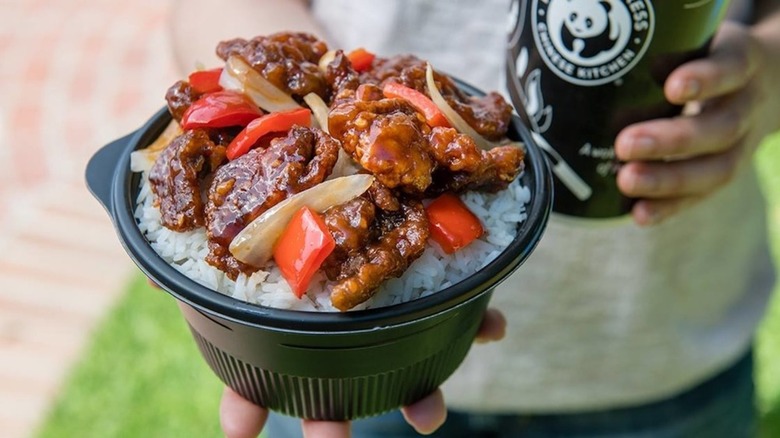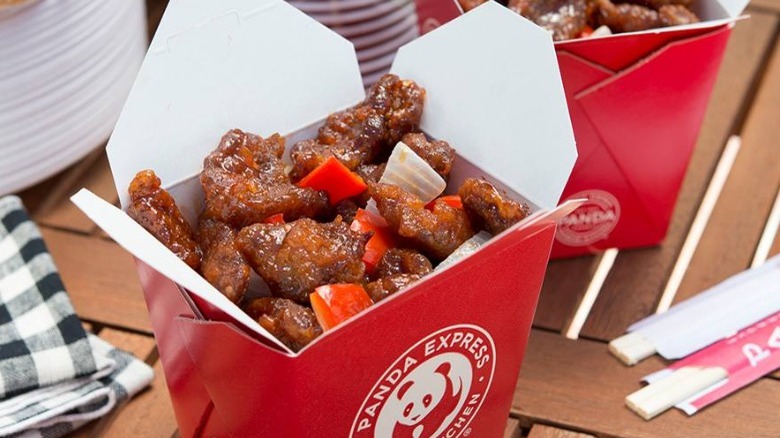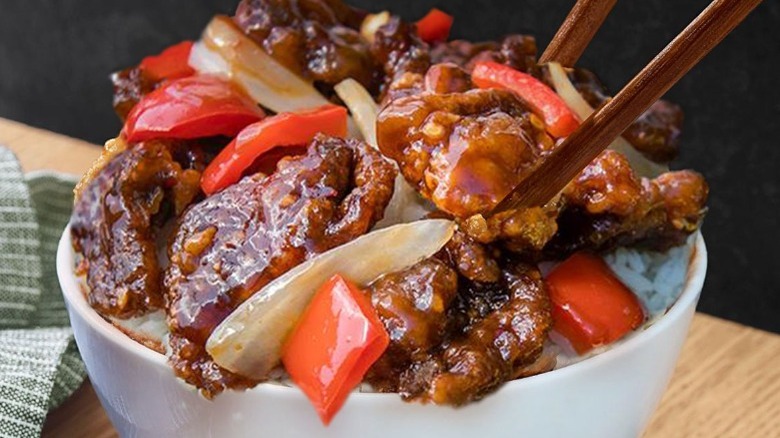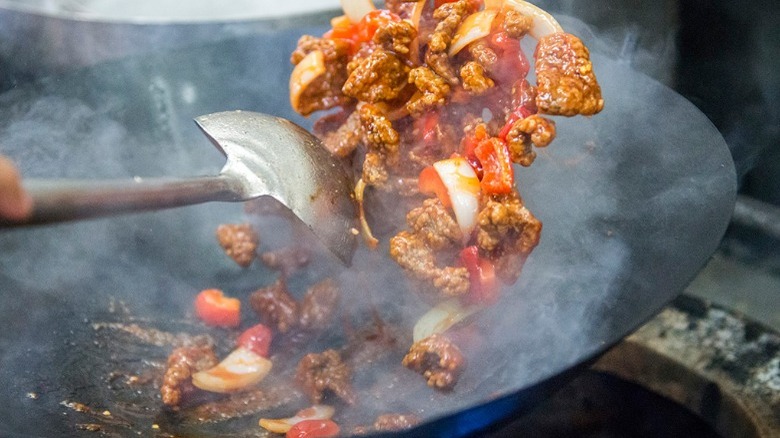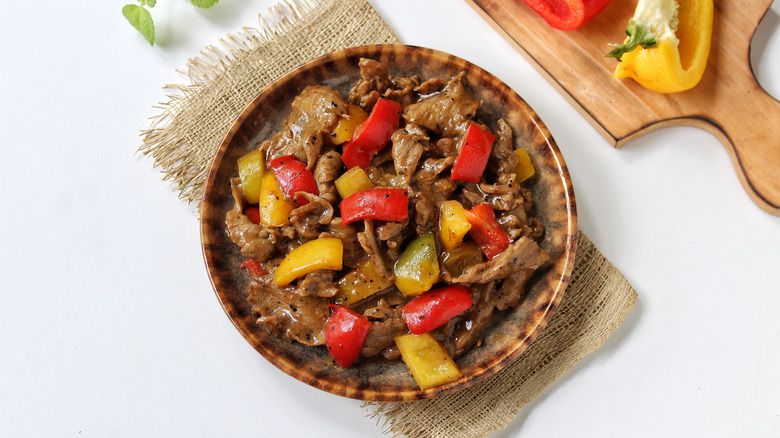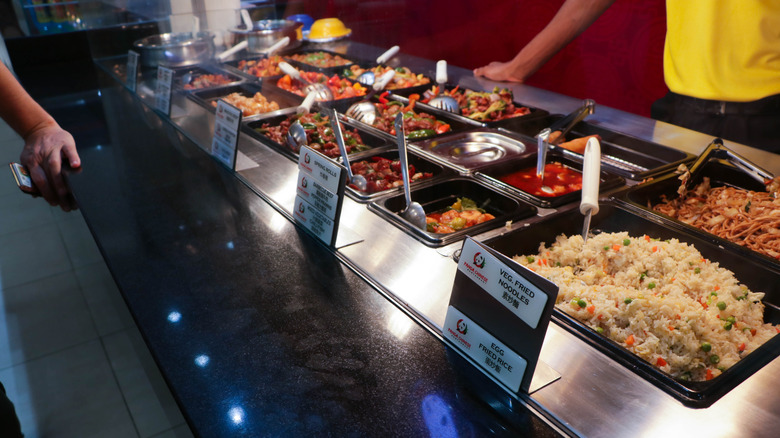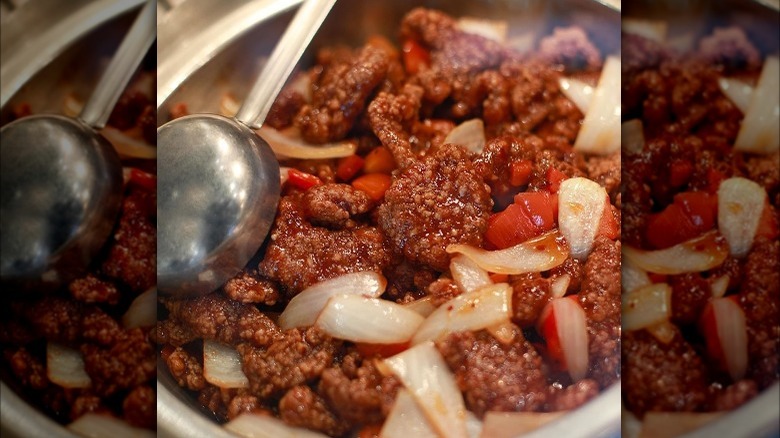Panda Express Beijing Beef: What To Know Before Ordering
Most customers may first visit Panda Express for the chain's famous orange chicken, but some of them come back for the Beijing beef. The sweet and spicy, battered beef and vegetable combo has been a marquee entree at Panda Express since it made its menu debut more than a decade ago, per QSR Magazine. Back then, for customers who appreciated their meals with a spicy zing, Beijing beef was the next best thing since sliced bread. And as current customers know, Panda Express has upped its menu game with additional spicy options since then, like kung pao chicken and SweetFire chicken breast.
But for some Panda Express goers, nothing will ever top the OG spicy entree. Customers have become so enamored by Beijing beef that the chain even bottled its sweet-tangy Beijing sauce to sell at Walmart. If you're on the fence about trying Beijing beef or are curious about its journey to Panda Express stardom, this article has you covered (or, at the very least, may give you a dinner idea).
What is Panda Express' Beijing beef?
On Panda Express' website, Beijing beef is described as "crispy beef, bell peppers and onions in a sweet-tangy sauce." Like most mains, Beijing beef can be added to any plate or bowl as one of your entree options, or dished a la carte. The latter doesn't mean it will come on the side (at Panda Express, fried rice, white rice, and chow mein are referred to as "sides"); rather, it is packaged in its own separately charged takeout box.
Beijing beef is one of a few spicy entrees currently available at Panda Express. It joins the high-heat ranks of SweetFire chicken breast, eggplant tofu, and kung pao chicken. According to Panda Express executive chef Andy Kao, who spoke with QSR Magazine, the idea for the wok-tossed Beijing beef stemmed from the chain's parent restaurant, Panda Inn. Beijing beef "was inspired by one of the most popular dishes at Panda Inn," Kao told the magazine. "Our goal was to create a unique dish that is a combination of crispy, tangy and tasty with both sweet and sour notes to tantalize our guests' palates."
When did it come out, and is it a permanent staple?
Per QSR Magazine, Beijing beef was officially added to the Panda Express menu in March of 2008. It was a historical roll-out for Panda Express because it was the first time in over 20 years that the Chinese-American chain had introduced a major new entree — on the heels of the fan-beloved orange chicken back in 1987. Fun fact: Beijing beef was Panda Express' first entree to have its own "comprehensive advertising campaign," appearing in commercials on the radio and TV.
Since its debut, Beijing beef has remained a permanent staple on the Panda Express menu. However, it did get a temporary boot during the COVID-19 pandemic back in 2020, when many restaurants, including Panda Express, had to limit menu options, among other changes. Thankfully for fans, this didn't last too long. About six months later, Panda Express was able to reinstate its full menu in the summer of 2020 (via Chew Boom). Based on the entree's 14-year run on the menu, it doesn't look like Beijing beef is going anywhere anytime soon.
How is it made?
Beijing beef is a hearty helping of battered strips of beef, plus bell peppers and onions, that are cooked in a hot, oiled wok in a sweet and tangy sauce. If you're looking to order the entree at Panda Express, that's pretty much all you need to know. But if you want to recreate the chain's Beijing beef at home, you'll have to do a bit of creative research, as the chain has not publicly shared the official recipe.
The good news is that the dish only has four main building blocks — beef, bell peppers, onions, and sauce — and there are a lot of Beijing beef copycat recipes out there. One by Dinner Then Dessert has you coat flank steak in egg and cornstarch, then pan-fry it until golden brown. The veggies are cooked in the browned bits in the same pan, then removed so the homemade sweet-tangy sauce can reduce over heat until thickened. The mixture includes sugar, ketchup, hoisin, vinegar, and a trio of sauces: soy, oyster, and sweet chili. The sauce, meat, and veggies are tossed together before serving. If you want to recreate the Panda Express dish for yourself, you could try that method — or go the hassle-free route and pick up a bottle of the chain's Beijing sauce at Walmart.
How does it taste?
On paper, it would seem that sweet and spicy lovers would enjoy Panda Express' Beijing beef for its signature sticky, tangy sauce. YouTube food reviewers 5 Minute Eats would have to agree. They awarded the entree a double thumbs up, calling it tastier than other beef-based Chinese dishes they've tried and saying it packed a flavorful punch. However, one critic said that there was so much sauce and breading that he couldn't tell that the meat was beef: "I was eating it initially and going, 'Wow, not bad. This is pretty good chicken.' And then I remembered, 'Oh my god, this is actually beef!'"
Fellow YouTuber Kollin Pork Chop also enjoyed the Beijing beef. In his review, he noted that the successful battering resulted in crispy beef. However, he stressed that the hype surrounding the dish's spice level is not accurate. There was no flinching or visual reaction to his bite, nor did he have to reach for a drink. If it were up to him, he would categorize it as mild, but definitely not spicy. Despite the lack of heat, Mashed ranked Panda Express menu items and listed this entree at third place, giving kudos to the multi-dimensional sauce.
How do you order it?
How do you order Beijing beef at Panda Express? Well, the answer really depends on how hungry you are and whether or not you want leftovers. Keep in mind that the chain prepares its entrees ahead of time, so substitutions aren't possible. Also, it may seem obvious, but the sweetness level can't be altered, nor are there options for different levels of heat (i.e. mild, hot, very spicy). After all, this is Beijing beef, not chicken wings.
If you browse Panda Express' website, you'll see that entrees can be ordered one of three ways. There's the bowl, which includes one side and one entree. An example of this would be fried rice and a scoop of Beijing beef. Those with a bigger appetite or wanting leftovers can opt for the plate (one side and two entrees) or the bigger plate, which comes with one side and three entrees. The latter is also a great shareable option. Don't forget that plate offerings allow customers to double (or triple) up on a select entree. In addition, Beijing beef can be ordered a la carte; small, medium, and large options are available.
How much does it cost?
Aside from the premium entrees, which include black pepper angus steak and honey walnut shrimp, all entrees at Panda Express cost the same amount. This is because you're ordering entrees as part of a specific meal type (bowl, plate, or bigger plate) or a la carte box size (small, medium, or large).
As with most fast food chains, prices may (and usually) vary based on where you live. That said, the best way to see how much entrees, such as Beijing beef, cost at your local Panda Express is to look it up using the website's store locator. After clicking around, it's clear that Manhattan locations have arguably the steepest prices. Panda Express chains in New York City charge $9.50 for a bowl, $11 for a plate, and $12.50 for a bigger plate. A la carte boxes start at $5.40 and go up to $11.40. For Beijing beef lovers who live outside of New York, the price of your meal could be $1 to $2 cheaper.
Nutritional information
Per Panda Express's website, a serving size (5.6 ounces) of Beijing beef has 470 calories, 21 grams of protein, 660 grams of sodium, and 5 grams of saturated fat. While the high protein count may help make it filling, it only has 1 gram of fiber. Meanwhile, the 46-gram carbohydrate count could make the dish overly carb-leaning, especially when paired with rice or chow mein. However, the real kicker is that a serving of Beijing beef has 24 grams of sugar. Based on American Heart Association guidelines, this is basically the threshold of a woman's recommended daily sugar intake (25 grams) and within reach of a man's recommended daily intake (36 grams).
Beijing beef has very few ingredients, so it's rational to conclude that a majority of the sugar comes from the sweet-tangy sauce. The bell peppers, meanwhile, pack in tons of nutrients, per Healthline, like vitamins C, A, and E. Those looking for less sugary menu options at Panda Express could consider the mushroom chicken, string bean chicken breast, or broccoli beef.
